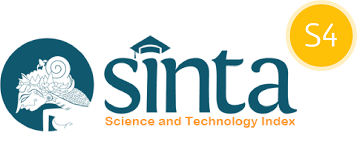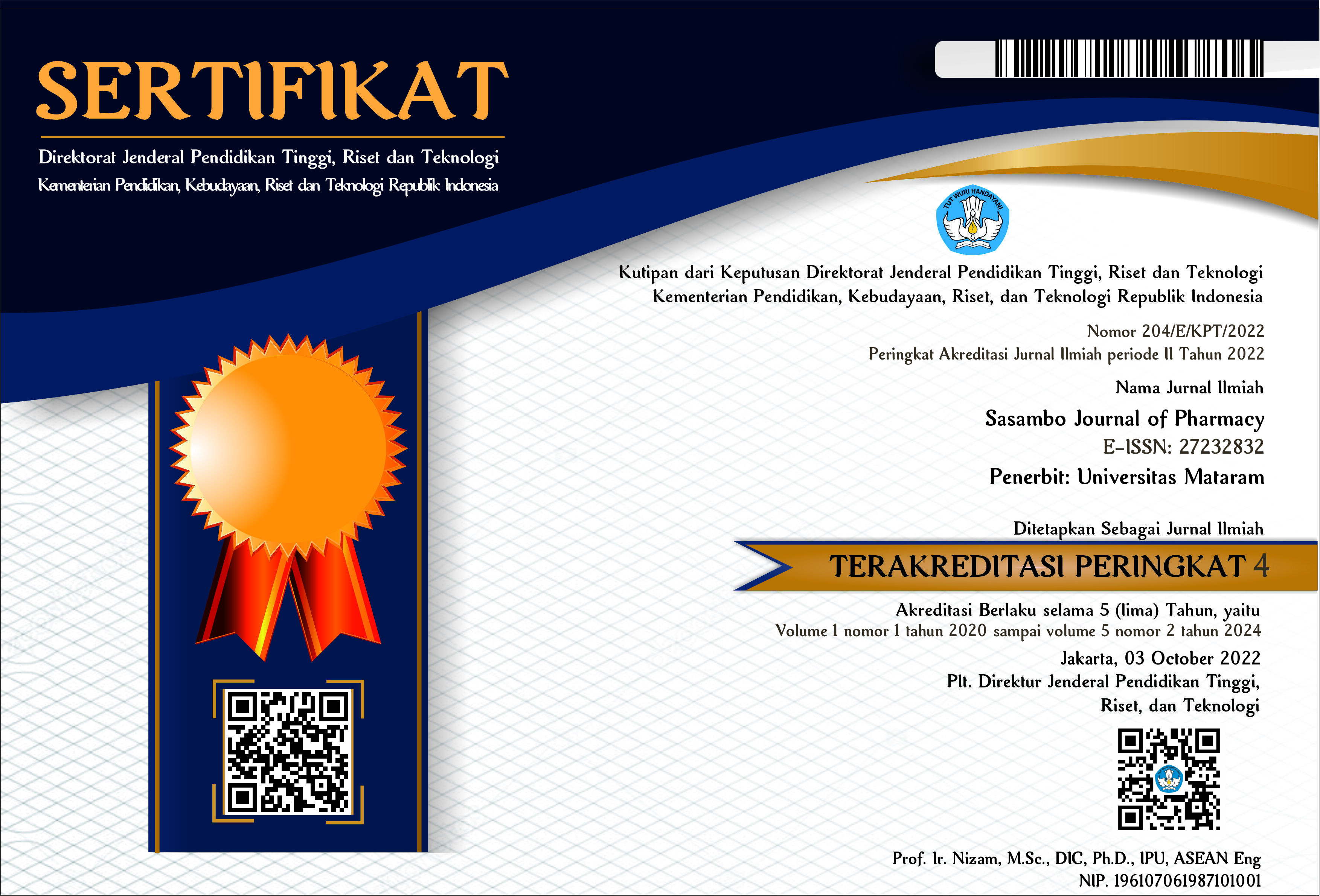Abstract
Starch is a group of complex carbohydrates containing amylose and amylopectin. Starch can be broken down into simpler molecules such as maltose, isomaltose, and glucose which is called the hydrolysis process. Starch hydrolysis is very useful in several food industries. Enzymatic hydrolysis of starch usually uses the amylase enzyme derived from saliva. However, if you are going to carry out the hydrolysis process on a large scale, it requires large amounts of enzymes. Therefore, this study aimed to examine the ability of enzymes in sprouts to hydrolyze starch and compare it with the ability of starch hydrolysis by saliva and HCl. The isolated sprout samples were added to the starch solution and then incubated at 37oC. Every 5 minutes the mixture was tested qualitatively with Benedict's test and iodine. The same treatment for saliva and HCL. However, HCl was incubated at 100oC. The results of the qualitative test using Benedict's test and the iodine test showed enzymatic process had a higher ability to hydrolyze starch than chemically with HCl. The α-amylase enzyme produced from sprouts showed a higher starch hydrolysis ability than saliva. Sprouts are a natural source that can be developed as a starch hydrolyzing agent.
Keywords:
sprouts, starch hydrolysis, enzymatic, chemically, salivaReferences
Acosta-Pavas, J. C., Alzate-Blandon, L., Ruiz-Colorado, A. A., Acosta-Pavas, J. C., Alzate-Blandon, L., & Ruiz-Colorado, A. A. (2020). Enzymatic hydrolysis of wheat starch for glucose syrup production. DYNA, 87(214), 173–182. https://doi.org/10.15446/dyna.v87n214.82669
Agustini, R., & Herdyastuti, N. (2020). The Study of Amylase's Reaction Kinetics From Soybean Sprouts (Glycine max L.) in Hydrolyzing Starch. 331–336. https://doi.org/10.2991/aer.k.201124.060
Azmi, A. S., Malek, M. I. A., & Puad, N. I. M. (2017). The review on acid and enzymatic hydrolyses of sago starch. International Food and Research Journal, 24, S265–S273.
Azmi, A., Yusuf, N., Jimat, D., & Mohamad Puad, N. I. (2016). Co-production of lactic acid and ethanol using rhizopus sp. From hydrolyzed inedible cassava starch and leaves. IIUM Engineering Journal, 17, 1–10. https://doi.org/10.31436/iiumej.v17i2.610
Bonechi, C., Consumi, M., Donati, A., Leone, G., Magnani, A., Tamasi, G., & Rossi, C. (2017). 1 - Biomass: An overview. In F. Dalena, A. Basile, & C. Rossi (Eds.), Bioenergy Systems for the Future (pp. 3–42). Woodhead Publishing. https://doi.org/10.1016/B978-0-08-101031-0.00001-6
Egharevba, H. O. (2019). Chemical Properties of Starch and Its Application in the Food Industry. In Chemical Properties of Starch. IntechOpen. https://doi.org/10.5772/intechopen.87777
Fleischer, H. (2019). The Iodine Test for Reducing Sugars – A Safe, Quick and Easy Alternative to Copper(II) and Silver(I) Based Reagents. World Journal of Chemical Education, 7(2), 45–52. https://doi.org/10.12691/wjce-7-2-3
George, R., & John. J, G. (2020). Thermostable Alpha-Amylase and Its Activity, Stability and Industrial Relevance Studies. SSRN Electronic Journal, 10(4), 1–11. https://doi.org/10.2139/ssrn.3574597
Jòzef, S. (2007). The Use of Starch Processing Enzymes in the Food Industry. In Industrial Enzymes: Structure, Function and Applications (pp. 19–34). https://doi.org/10.1007/1-4020-5377-0_2
Masrullita, M., Dewi, R., Aji, A., Meriatna, M., & Yulisa, S. (2020). Pembuatan Glukosa Cair dari Pati Singkong (Manihot esculenta C) secara Hidrolisis menggunakan Katalis Asam Klorida. Jurnal Teknologi Kimia Unimal, 8(2), 1–14. https://doi.org/10.29103/jtku.v8i2.2678
Mayer, F. C., & Larner, J. (2002). Substrate Cleavage Point of the α- and β-Amylases1. ACS Publications, 81(6), 188–189. https://doi.org/10.1021/ja01510a043
McKie, V. A., & McCleary, B. V. (2015). A rapid, automated method for measuring α-amylase in pre-harvest sprouted (sprout damaged) wheat. Journal of Cereal Science, 64, 70–75. https://doi.org/10.1016/j.jcs.2015.04.009
Simoni, R., Hill, R., & Vaughan, M. (2002). Benedict's Solution, a Reagent for Measuring Reducing Sugars: The Clinical Chemistry of Stanley R. Benedict. Journal of Biological Chemistry, 277, e5–e6. https://doi.org/10.1016/S0021-9258(19)61050-1
Suarni, S., & Patong, R. (2010). Potency Of Mung Bean Sprout As Enzyme Source (Α-Amilase). Indonesian Journal of Chemistry, 7(3), 332–336. https://doi.org/10.22146/ijc.21679
Sulastri. (2010). Studi Aktivitas Enzam Amilase Air Ludah (saliva) Manusia Terhadap Pati [Skripsi], Universitas Negeri Yogyakarta]. https://eprints.uny.ac.id/5460/
Wang, S., & Copeland, L. (2015). Effect of acid hydrolysis on starch structure and functionality: A review. Critical Reviews in Food Science and Nutrition, 55(8), 1081–1097. https://doi.org/10.1080/10408398.2012.684551
License
Copyright (c) 2022 The Author(s)

This work is licensed under a Creative Commons Attribution 4.0 International License.
Authors who publish with Sasambo Journal of Pharmacy (SJP), agree to the following terms:
- Authors retain copyright and grant the journal right of first publication with the work simultaneously licensed under a Lisensi Creative Commons Atribusi 4.0 Internasional. This license allows authors to use all articles, data sets, graphics and appendices in data mining applications, search engines, web sites, blogs, and other platforms by providing an appropriate reference. The journal allows the author(s) to hold the copyright without restrictions and will retain publishing rights without restrictions.
- Authors are able to enter into separate, additional contractual arrangements for the non-exclusive distribution of the journal's published version of the work (e.g., post it to an institutional repository or publish it in a book), with an acknowledgment of its initial publication in Sasambo Journal of Pharmacy
- Authors are permitted and encouraged to post their work online (e.g., in institutional repositories or on their website) prior to and during the submission process, as it can lead to productive exchanges, as well as earlier and greater citation of published work (See The Effect of Open Access).







